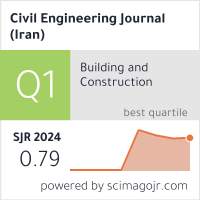The Effect of Local Fuse on Behavior of Concentrically Braced Frame by a Numerical Study
Downloads
The concentrically braced frames (CBFs) are one of the most widely used lateral load-resisting systems. Seismic performance of these structures has a weakness that is due to the brace buckling at a lower loading than the ultimate compressive loading capacity. In this paper, attempt is made to enhance the seismic response of CBFs through utilizing a local fuse. For this purpose, first the formulation of fuse area and length are presented. Then based on this formulation, several numerical models have been built and analyzed to examine the effect of implementing this fuse on seismic response of CBFs. From the analyses results, it is found that if the reduced cross-section fuse (RCF) is properly designed and also the end of brace is fixed, the CBFs with equal energy dissipation capacity, that are equipped with this fuse exhibit a better ductility than the customary CBFs.
Downloads
http://www.palldynamics.com/fr/pdf/40Pall_doc1.pdf.
[2] Jurukovski, D., and B. Simonov. "Effectiveness of energy absorbing elements in composite steel frame.” Proceedings of the 9th World Conference on Earthquake Engineering (August 1988) Tokyo Kyoto, Japan.
[3] Sabouri-Ghomi, S. and A. Roufegarinejad. "Non-linear behavior of yielding damped braced frames.” Struct. Design Tall Spec. Build. 14 (2005): 37-45. DOI: https://doi.org/10.1002/tal.257.
[4] Sabouri-Ghomi, S. and B. Payandehjoo. "Investigating the effect of stiffness and strength of each component on overall stiffness and strength of yielding damped braced core (YDBC).” J. Struct. Design Tall Spec. Build. 20 (2011): 747–756. DOI: https://doi.org/10.1002/tal.526.
[5] Jia, M., D. Lu, L. Guo, and L. Sun. "Experimental research and cyclic behavior of buckling restrained braced composite frame.” J.Construct. Steel Res. 95 (2014): 90-105. DOI: https://doi.org/10.1016/j.jcsr.2013.11.021.
[6] Sabeli, R., S. Mahin, and C. Chang. "Seismic demands on steel braced frame buildings with buckling restrained braces.” J. Eng. Struct. 25(5) (2003): 655-666. DOI: https://doi.org/10.1016/S0141-0296(02)00175-X.
[7] Hoveidae, N., R. Tremblay, B. Rafezy and A. Davaran. "Numerical investigation of seismic behavior of short-core all-steel buckling restrained braces.” J.Construct. Steel Res. 114 (2015): 89-99. DOI: https://doi.org/10.1016/j.jcsr.2015.06.005.
[8] Maurya, A., M.R. Eatherton, R. Matsui and S.H. Florig. "Experimental investigation of miniature buckling restrained braces for use as structural fuses.” J.Construct. Steel Res. 127 (2016): 54-65. DOI: https://doi.org/10.1016/j.jcsr.2016.07.019.
[9] Moghaddam, H., and H. Estekanchi. "Seismic behavior of off-centre bracing systems.” J.Construct. Steel Res. 51(2) (1999): 177-196.DOI: https://doi.org/10.1016/S0143-974X(99)00007-3.
[10] Bazzaz, M., Z. Andalib, A. Kheyroddin, and M.A. Kafi. "Numerical comparison of the seismic performance of steel rings in off-centre bracing system steel rings in off-centre bracing system.” Steel Compos. Struct., Int. J. 19(4) (2015): 917-937. DOI: 10.12989/scs.2015.19.4.917.
[11] Bazzaz, M., A. Kheyroddin, M.A. Kafi, Z. Andalib, and H. Esmaeili. "Evaluating the seismic performance of off-centre bracing system with circular element in optimum place.” Int. J. Steel Struct. 14(2) (2014): 293-304. DOI: 10.1007/s13296-014-2009-x.
[12] D'Aniello, M., S. Costanzo, and R. Landolfo. "The influence of beam stiffness on seismic response of chevron concentric bracings.” J.Construct. Steel Res., 112 (2015): 305-324. DOI: https://doi.org/10.1016/j.jcsr.2015.05.021.
[13] Qu, B., F. Sanchez-Zamora, and M. Pollino. "Mitigation of inter-story drift concentration in multi-story steel concentrically braced frames through implementation of rocking cores.” J. Eng. Struct. 70 (2014): 208-217. DOI: https://doi.org/10.1016/j.engstruct.2014.03.032.
[14] Qu, Z., A. Wada, S. Motoyui, H. Sakata, and S. Kishiki. "Pin-supported walls for enhancing the seismic performance of building structures.” J. Earthq Eng Struct Dyn. 41(14) (2012):2075-2091. DOI: https://doi.org/10.1002/eqe.2175.
[15] Kumar, A., D.R. Sahoo, and N. Kumar. "Limiting values of slenderness ratio for circular braces of concentrically braced frames.” J.Construct. Steel Res. 115 (2015):223-235. DOI: https://doi.org/10.1016/j.jcsr.2015.08.026.
[16] Federico, G., R. Fleischman, and K. Ward. "Buckling control of cast modular ductile bracing system for seismic-resistant steel frames.” J.Construct. Steel Res. 71 (2012): 74-82. DOI: https://doi.org/10.1016/j.jcsr.2011.11.010.
[17] Ward, K.M, R.B. Fleischman, and G. Federico. "A cast modular bracing system for steel special concentrically braced frames.” J. Eng. Struct. 45 (2012): 104-116. DOI: https://doi.org/10.1016/j.engstruct.2012.05.025.
[18] Legeron, F., E. Desjardins, and E. Ahmed. "Fuse performance on bracing of concentrically steel braced frames under cyclic loading.” J.Construct. Steel Res. 95 (2014): 242-255. DOI: https://doi.org/10.1016/j.jcsr.2013.12.010.
[19] Desjardins, E., F. Legeron, and E. Ahmed. "Performances of ductile fuses in reducing seismic demand on connections of concentrically steel braced frames” 15th World conference on Earthquake Engineering (Sep. 2012), Lisbon, Portugal.
[20] Bonetti, S.”Ductile fuses for special concentrically braced frames.” Ph.D. Dissertation, Kansas University, Kansas, US of America (2012).
[21] Shen, J., O. Seker, N. Sutchiewcharn and B. Akbas. "Cyclic behavior of buckling-controlled braces.” J.Construct. Steel Res. 121 (2016): 110-125. DOI: https://doi.org/10.1016/j.jcsr.2016.01.018.
[22] Seker, O. and J. Shen. "Developing an all-steel buckling controlled brace.” J.Construct. Steel Res. 131 (2017): 94-109. DOI: https://doi.org/10.1016/j.jcsr.2017.01.006.
[23] Momenzadeh, S., O. Seker, M. Faytarouni and J. Shen. "Seismic performance of all-steel buckling-controlled braces with various cross-sections.” J.Construct. Steel Res. 139 (2017): 44-61. DOI: https://doi.org/10.1016/j.jcsr.2017.09.003
[24] ABAQUS Ver .6.12. "User's Manual.” USA: RI (2012).
[25] AISC. "Specification for structural steel building, American Institute of Steel Construction.” (2010).
- Authors retain all copyrights. It is noticeable that authors will not be forced to sign any copyright transfer agreements.
- This work (including HTML and PDF Files) is licensed under a Creative Commons Attribution 4.0 International License.![]()















